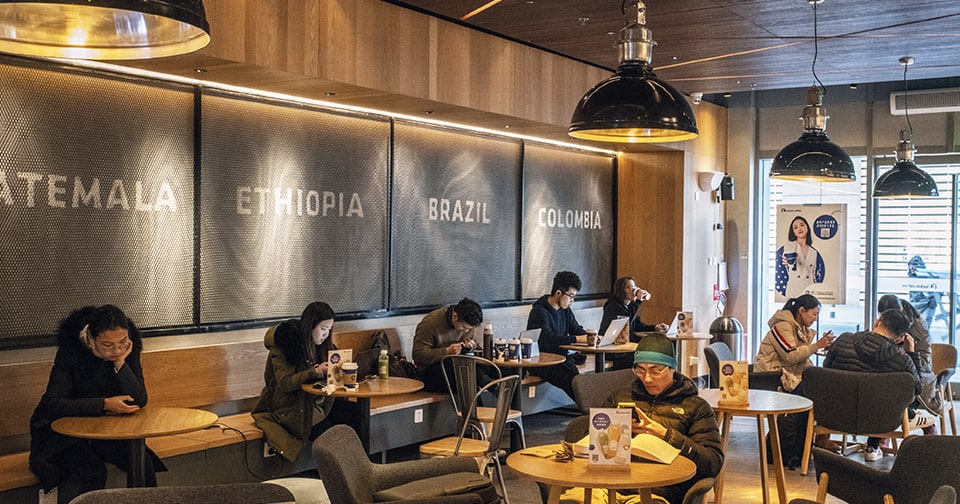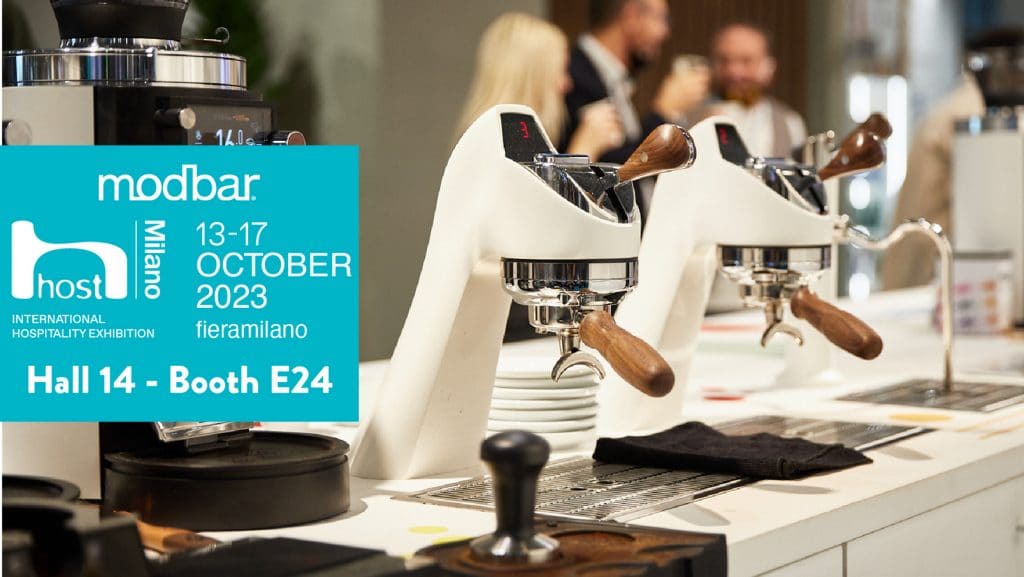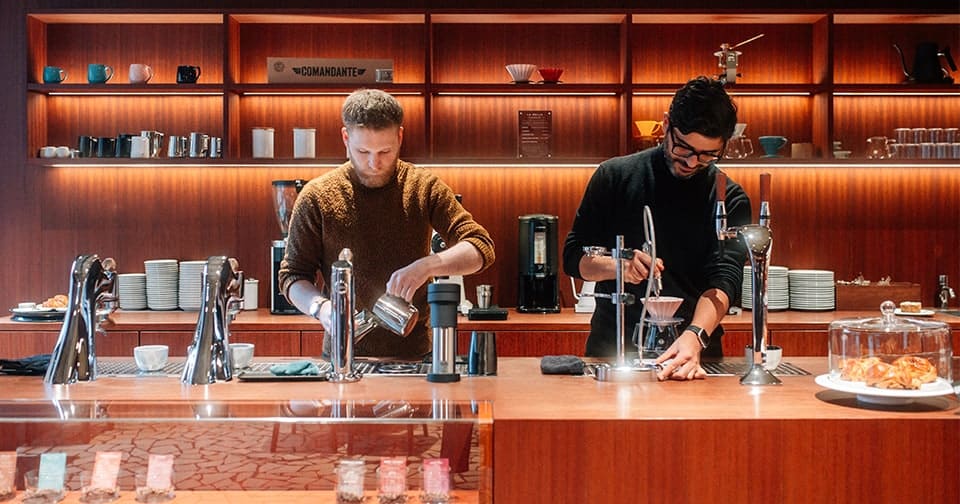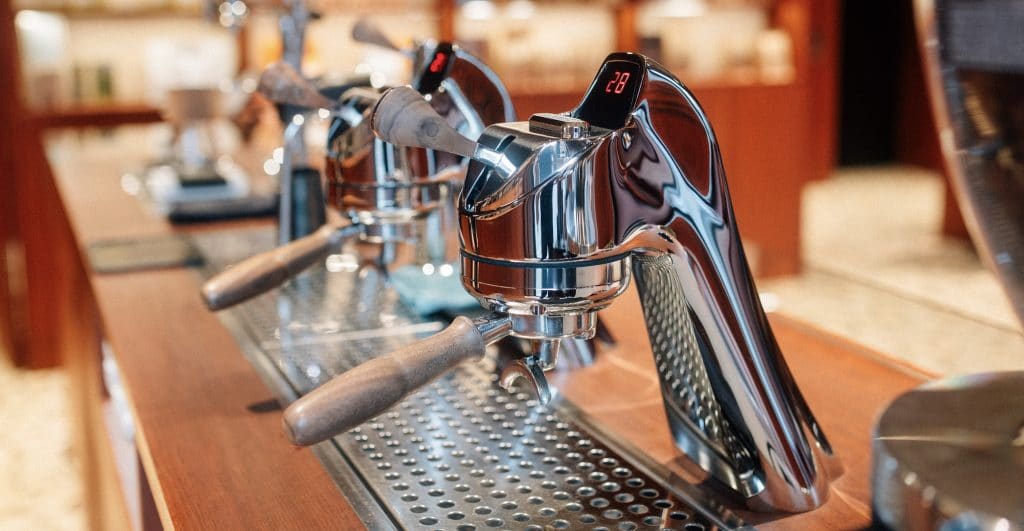
On the ground floor of central Beijing’s Shimao Gongsan Plaza shopping mall, a highly caffeinated standoff is taking place.
A few steps along from a branch of Japanese clothes store Muji, most of the seats in a Starbucks branch are full. Their occupants, with eyes invariably harpooned towards smartphones, are drinking 35 yuan (£4) Americanos as they give their arms respite from the weight of heavily stuffed shopping bags.
A five-second walk further north, the new kid in town and country has set up shop. There are a few bar stool-style seats next to the Luckin Coffee service booth, but they remain unused as the apron-wearing baristas do a steady trade in take-out coffees, sold at around 80% of the price of the US neighbour. As Luckin customers stroll purposeful out of the mall as they sip, Starbucks counterparts faff over branded tat in the queue.
Launched in October 2017, Luckin Coffee, a Chinese startup brand of coffee outlets, has seemingly come from nowhere to be considered a serious contender for Starbucks’ high street coffee crown in the country.
Having operated in China for 20 years, in January 2019 Starbucks had 3,521 stores in the country and is aggressively expanding there, as it concentrates on the land of tea as its main market globally.
In January Luckin had 2,000 outlets, and aims to reach a figure of 4,500 before the end of the year. If achieved, it would likely overtake Starbucks’ outlet count, which is expected to be around 4,100 by the end of 2019.
Starbucks successfully brands itself as premium in China, increasingly focusing on drink-in experience with inviting venues typified by Shanghai’s Roastery outlet: at 30,000 square feet the world’s biggest Starbucks branch, which comes across as more of a theme park than a café. In contrast Luckin is all about digital, delivery and discount.
In May, Luckin debuted on the Nasdaq exchange at US$25 a share. The company’s ascending firework profile has led many industry observers to view it as a serious challenge to Starbucks in China.
Roast loyal?
Amid the hype, there are equally serious concerns that the brand is offering sweeteners over substance. Having spent US$111m in 2018 on advertising and marketing, plus offering huge discounts as standard, that year the company lost US$123m.
Luckin has not been shy about its Starbucks-smashing ambition, giving bullish public statements about growth while making no bones about the strength of its rival behind closed doors. Peter Radosevich, international sales team leader with coffee trading firm Royal Coffee, told Foodservice Consultant that Luckin had poached high-ranking Starbucks corporate staff, tempting them with inflated salary offers.
In January, Luckin CEO Qian Zhiya said the company “aims to become China’s biggest coffee chain brand by the year end, totally surpassing Starbucks by cups of coffee sold and number of shops.”
It is far from another Chinese copycat company. Although Luckin is too new for its brand values to be solidified among the public, in contrast to Starbucks’ premium public image, the newcomer has become known as providing mediocre drinks extremely conveniently. Only available via digital purchase, consumers order via China’s ubiquitous messaging and payment app WeChat then pick up from an outlet or have it delivered. Almost all orders are heavily discounted.
With Luckin continuing to lose millions of dollars per month largely due to discounting, there can only be so much runway left. However Yuwan Hu, consultant with Daxue Consulting, believes that Luckin’s heavy discounting will need to continue for most of the following year for it to have a good shot at becoming profitable.
“If you have Starbucks and Luckin Coffee in front of you, at the same price, people choose Starbucks,” she says. “But if consumers get used to it [through discount buying] they will re-buy Luckin coffee on a regular basis. But they still need a certain amount of time to do so.”
Hu compares the strategy to that of Chinese car-hailing app DiDi, which has become widely used in China following its launch in 2015 with an extended period of discounted rides. Now, with heavy discounting not regularly on offer, DiDi remains the go-to ride choice for many, despite rides not being much cheaper than street-hailed taxi rides.
Radosevich says that Luckin may find long-term success by focusing on Chinese cities beyond the enormous ‘tier one’ cities such as Beijing and Shanghai, where coffee competition is most fierce and customer habits are more established. Trendy cafes may be common in the hipster streets of cosmopolitan Shanghai, but China as a whole has a tiny per capita consumption rate of around six cups. It’s still a new market in most places.
“In a lot of ways Luckin and Starbucks are attempting to serve different parts of the market,” says Radosevich. “It’s possible that Luckin will be more successful in tier two and tier three cities rather than in tier one cities because consumers who have less disposable income are going to be more attracted to the value that Luckin offers than people in Shanghai or Beijing.”
Hu agrees. “In the most highly developed cities we can see people are consuming coffee every day, especially white-collar workers,” she says. “But in the lower tier cities many people are not into this coffee culture. Education is coming in terms of coffee drinking, and people are growing more familiar with it [coffee culture].”
Power brand
With such outlay there remains potential for a spectacular Luckin Coffee failure once the financial runway runs out of tarmac. Adding to the danger is Starbucks’ increasingly proactive response to the company’s thrust into its market.
Luckin has opened many outlets that are delivery-only, with Starbucks responding by opening more small stores focusing on quick service rather than cosy seating and ‘experience’ – although stores offering the latter are opening just as frequently.
Also, somewhat late to the delivery party, last year Starbucks teamed up with China’s Ele.me delivery app, to help close the convenience gap between the US company and the bullish Chinese startup. Wang Zhendong, chairman of Shanghai Feiyue Investment Management Co Ltd, told Ecns.cn: “Starbucks has been preoccupied so much on opening more and bigger stores in China in recent months that its new delivery project appears more like a passive defence against the fast rise of Luckin.”
Defensive moves by Starbucks may be uncharacteristic in China, where the company has been confidently attack-minded over the past two decades. But despite the impressive numbers of the Chinese newcomer, the US firm’s iron-strong brand values are not to be underestimated. Sometimes viewed in the West as a negative bastion of global capitalism, in China Starbucks is established as a cool, desirable brand worth shouting about on social media.
Today, Beijing’s Starbucks venues are rarely quiet, with customers often paying as much attention to logo-adorned trinkets sold at the counter as they do the drinks. In lower tier Chinese cities people walk around with cheap coffee poured into knockoff Starbucks mugs, fooling onlookers into thinking they’re sipping with the elite.
That’s a hard image to puncture, and if both Luckin and Starbucks are to thrive it may be that their direct rivalry eventually dissipates, as they occupy differing tiers of the market. That the consensus that Starbucks coffee is way, way better tasting than Luckin’s seems almost secondary.
Jamie Fullerton




